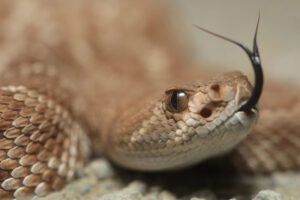San Diego County Rattlesnakes

For many of us who own dogs, rattlesnakes are a real concern. We may feel like we can avoid them ourselves, but feel less certain that our dogs can do the same. In addition to training our dogs to avoid rattlesnakes, it is also important to understand the rattlesnakes themselves and to acquire information about that animal we may fear.
Why Rattlesnakes Matter
Rattlesnakes are beneficial to our ecosystem. They prey on rodents that damage crops and other plants, helping to control hantavirus, a disease harmful to humans that rodents spread through their fecal matter. San Diego County has a wide variety of plants and animal species and is known as a biodiversity hotspot. At the same time, it is a hotspot for biodiversity loss, with the highest rate of habitat loss in the continental United States. Rattlesnakes in San Diego County suffer from indiscriminate killing and collection, in addition to habitat loss.
How are rattlesnakes different from other snakes? Rattlesnakes belong to the viper family, and specifically the subfamily of pit vipers, named for the pit organ between the eyes and nostrils. They use that pit as an infrared sensor to detect prey and direct strikes. Rattlesnakes are venomous (not poisonous) and inject venom into their prey to still them. They will also bite and use the venom to stop an attacker. Rattlesnakes do not attack people or dogs, but they will defend themselves, if needed.
The Rattlesnakes That Live Among Us
There are four species of rattlesnake in San Diego county, some more likely to be seen than others. If you live in an area with a lot of rattlesnake activity, heed warning signs to keep you and your dog safe.
The Colorado Desert Sidewinder (crotalus cerastes laterorepens) is San Diego County’s smallest rattlesnake and it is commonly found in sandy flats and washes. It is typically active at night, and will rattle and flee when approached. It’s nickname is the “horned rattlesnake,” named for the horns above its eyes.
The Red Diamond Rattlesnake (crotalus ruber ruber) is San Diego County’s largest venomous snake. At the same time, it is the second least venomous of San Diego’s rattlesnakes. Found frequently on rocky hillsides, it is active all year-round, although most-active from April to November. This snake rarely rattles or strikes when approached. It is a CA Species of Special Concern.
The Southwestern Speckled Rattlesnake (crotalus mitchelli pyrrhus) can be found in a variety of skin colors on rocky hillsides from the coast to the desert. Depending on the substrate, the colors patterns may be light or dark to assist with camouflage. They are active from March to September and remain quietly coiled unless harassed.
The Southern Pacific Rattlesnake (crotalus helleri), also known as the Western Rattlesnake, is the second largest and most dangerous rattlesnake in San Diego County. It has the most toxic venom of the four species listed here. The most commonly encountered, the Southern Pacific lives in urban areas as well as the near the beach and in the mountains. It is typically active during the day from March to October, but may be nocturnal during hotter weather.
Staying Safe
Keeping you and your dog safe when hiking in rattlesnake areas requires diligence and training. I teach people how to cue their dogs away from snakes without using shock or other aversive and painful equipment. If interested, go to my training page and find out more about my private training opportunities. Education and Safety are good things.
Resource
If you want to know more about these rattlesnakes, or about other reptiles in San Diego County, check out The California Natural History Guides Field Guide to Amphibians and Reptiles of the San Diego Region by Jeffrey M. Lemm. I used it as a source here and it is packed full of great photos and facts. I highly recommend it!
Lynn Webb, M.A., KPA CTP, CTMT


